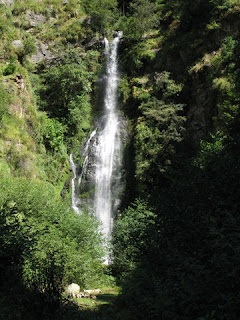We spent 2 days in Paro - or actually two nights. The first day we went up to Tiger's Nest. Since our flight was delayed we were able to do some more shopping and watch part of an archery tournament. Archery is the national sport of Bhutan. They compete with both traditional bows made of bamboo and the newer compound bows that are used in international competition.
Chimmi said that this was part of a national tournament, but it was not clear whether this was a regional event leading up to the nationals, or the actual national tournament. There were 3 teams competing, each with 5 members.
If a team member hits the target there is a victory dance and song at both ends of the field. Each team shoots 3 arrows, then they move to the opposite end. One of the flags was in the way, but can get the idea.
The target is quite small - a circle about a foot in diameter drawn on a white board that measures about 15 inches across and maybe 2.5 ft high. You get 1 point for hitting the board and 3 for getting an arrow in the circle. The target is 180 - 200 meters from the archer. Amazing that they ever hit it.
One left-handed archer enabled me to see the front of him.
Chimmi said that this was part of a national tournament, but it was not clear whether this was a regional event leading up to the nationals, or the actual national tournament. There were 3 teams competing, each with 5 members.
If a team member hits the target there is a victory dance and song at both ends of the field. Each team shoots 3 arrows, then they move to the opposite end. One of the flags was in the way, but can get the idea.




















